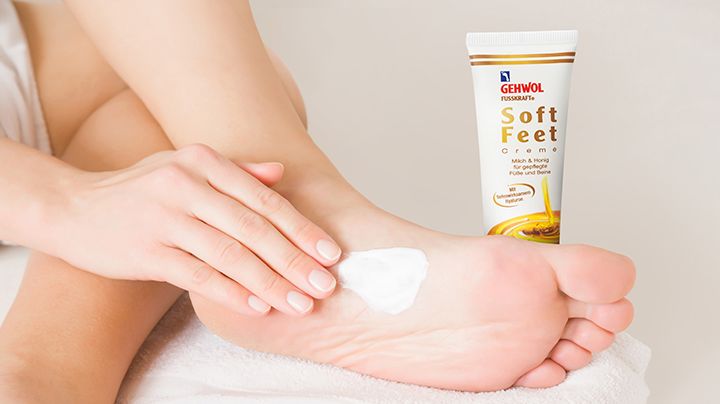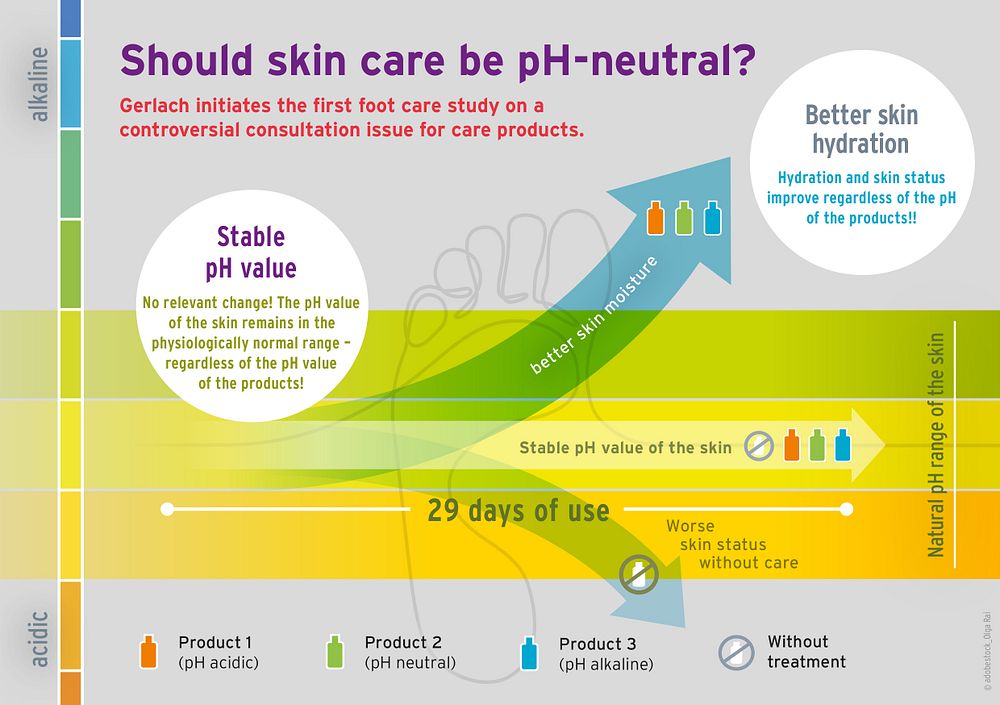
Press release -
Do foot care products have to be pH-neutral? First clinical study on an old myth
Healthy skin has a rather acidic environment, with a pH value between pH 4 and pH 6. In this area, which is disadvantageous for fungi and germs, the skin can optimally exercise its protective barrier function. This also applies to the feet. However, care products may have slightly higher pH values if this is necessary for reasons of galenic stability, or the due to the utilized ingredients and their properties. However, the question of whether products with a different pH value change the skin environment is controversial, and has therefore now been clinically investigated for the first time in a controlled study1 for the feet. The study was commissioned by Eduard Gerlach GmbH (GEHWOL) and is intended to improve the evidence on this question of understanding the effect of cosmetic formulations, which is important for both healthcare professionals and consumers. The result shows that the pH value of a formulation has no physiologically relevant influence on the pH value of the skin. Thanks to its buffering capacity, it is able to compensate for pH fluctuations in the short term. Consequently, different pH values also have no significant influence on desired care goals such as skin moisturization. In the study, all products proved to be comparably effective and well tolerated, regardless of their pH value.
The skin is the body's largest organ and has an important protective function. For example, it protects the skin from harmful environmental influences, microorganisms and chemicals. The so-called acid mantle of the skin (acid-alkali balance) is also involved in this barrier function. This hydrolipid film is a mixture of sebum, callus cells and sweat, and lies on the skin as a fine protective film. The pH value of the skin describes the ratio of acids and alkalis, and ranges from pH 0 (acidic) to pH 14 (alkaline). The acid-alkali balance of the hydrolipid barrier is within the slightly acidic range - hence the term "acid mantle". However, the pH value varies depending on the body region. On the foot, for example, the skin of the foot sole, which is free of sebaceous glands but has more sweat glands, has completely different conditions than the top or the areas between the toes. Overall, the physiological normal range for healthy skin is pH 4-6. Bacteria, fungi and pathogens that are not part of the skin's natural biofilm don’t do well in this range. In order to support the barrier function, it is important that care products do not alter the physiological skin pH value.
Care products may have different pH values for reasons of galenic stability. The properties of the ingredients used in the product, for example with regard to their solubility or their pH-dependent effective ranges, may also make it necessary to adjust the pH value. With a view to the very specific environments of the individual foot regions, a clinical study has now been conducted for the first time to investigate whether foot care products with different pH values may have a lasting effect on the skin's pH value or influence the skin's overall condition differently. The study, which was conducted by the proderm Institute for Dermatological Research on behalf of Eduard Gerlach GmbH (GEHWOL), was accepted for publication by the International Journal of Cosmetic Science and published online on 4. April 2023.1
Study: Influence of different product pH values on the skin environment and skin status
60 test subjects, including 30 with type 1 or type 2 diabetes, used different test products over a period of 29 days according to a randomized, double-blinded block design. A neutral foot care product (pH 6.9 to 6.25), one in an acidic range (pH 4.5 to 4.63) and one in the alkaline range (pH 8.5 to 8.14) were given to equally sized test groups. The test groups each used two of the three test products, one on the left foot, the other on the right foot, applying them in the mornings and evenings on defined test areas: the top of the foot, the heel, the ball of the foot and between the toes. The control group only used one of the test products, while their other foot remained untreated. The block design resulted in 30 samples for each of the test products and the negative control. Skin pH, skin moisture (hydration) and dermatological skin status were evaluated before the start of care (baseline), on day 15 and on day 29 (after the end of the application period). During the status assessment, symptoms such as skin dryness, calluses, fissures and cracks as well as various tolerance characteristics (e.g. redness, scaling, papules, pustules, oedema, blisters, oozing) were objectively evaluated. Participants also provided information about how their skin felt (e.g. itching, burning, tingling, tightness, etc.).
No physiologically relevant change in skin pH
The various tests showed that the integrity of the skin barrier was maintained by all three test products - without any influence from their respective pH value. On the one hand, the foot care creams had no physiologically relevant influence on the foot skin’s pH. This was largely unchanged at the end of the test period, regardless of whether the acidic, neutral or alkaline product had been used. Mean pH also did not differ statistically from the negative control without treatment. Only the back of the foot showed a very slight increase in average pH for all three products, although these were still clearly within the physiological normal range of the skin. The study also showed no difference between the three test products at the end of the treatment period in terms of skin hydration as a further parameter of barrier function. After 29 days, all products increased the moisture content of the skin; the increase was strongest and most statistically significant on the back of the foot.
The dermatological evaluation of product efficacy showed that calluses, cracks, fissures and dry skin worsened without care during the course of the study, while skin condition improved when one of the three foot care products was used or, in the case of calluses, initial levels were maintained. The objectively and subjectively assessed skin status also improved with the test products, but not in the control group, where a deterioration was recorded for the parameters scaling, skin dryness and feeling of dryness. No difference was found between the individual products with different pH values in terms of their efficacy or influence on skin condition.
The results of the study confirm the hypothesis that the skin is able to compensate for pH fluctuations in the short term, due to its high buffering capacity. Slightly increased pH values in a care product therefore do not disturb the acidic pH value of the skin on the feet, which means that the corresponding products have just as beneficial an effect on skin moisture and skin status on the feet as pH-neutral or neutral products if the formulation is suitable overall. Products with a pH in the acidic range. In their conclusion, the authors therefore emphasize that the initial pH of a foot care cream is not a suitable indicator of its skin-nourishing properties.

For the area of foot care, the study confirms the hypothesis that the skin is able to compensate for pH fluctuations thanks to its high buffering capacity. The pH value of a cream is therefore not the decisive indicator for its skin-caring properties. Rather, it is the ingredients and the way they are formulated in the product that are decisive. ‘pH-neutral skin care should therefore at best be understood as an emulsion that does not change the skin's natural pH value, but optimally improves its dermatological condition. The pH value is not a decisive criterion for the selection of a skincare product as long as it is a high-quality formulation.

Dr Andreas Fitzner,
responsible author of the study and Head of Research & Development at foot care specialist GEHWOL
Short version 1,300 characters incl. spaces
Long version: 6,200 characters incl. spaces
Reprints free of charge / voucher requested
Study:
[1] Fitzner A, Knuhr K, Brandt M, Bielfeldt S. Investigating the effect of the pH of foot care product formulations on pedal skin in diabetic and non-diabetic subjects. International Journal of Cosmetic Science. First published: 04 April 2.023 (doi:10.1111/ics.12861)
Related links
Topics
Categories
With its GEHWOL brand cosmos, Eduard Gerlach GmbH is one of the most popular full-range suppliers of foot care products and technology and the market leader in the specialised foot care trade. Based on in-house research and development, the full range includes cosmetics, medical products and pharmaceuticals for foot care and foot health with different dosage forms, galenics and active ingredient formulations as well as for different skin types and skin problems. The products are available exclusively in foot care and podiatry practices, cosmetic institutes and pharmacies.


